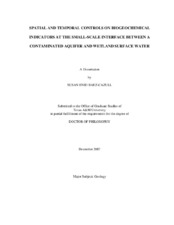| dc.contributor.advisor | McGuire, Jennifer T. | |
| dc.creator | Baez-Cazull, Susan Enid | |
| dc.date.accessioned | 2010-01-15T00:08:12Z | |
| dc.date.accessioned | 2010-01-16T00:38:34Z | |
| dc.date.available | 2010-01-15T00:08:12Z | |
| dc.date.available | 2010-01-16T00:38:34Z | |
| dc.date.created | 2007-12 | |
| dc.date.issued | 2009-05-15 | |
| dc.identifier.uri | https://hdl.handle.net/1969.1/ETD-TAMU-2520 | |
| dc.description.abstract | This high-resolution biogeochemical study investigated spatial and temporal
variability in the mixing interface zones within a wetland-aquifer system near a
municipal landfill in the city of Norman, Oklahoma. Steep biogeochemical gradients
indicating zones of enhanced microbial activity (e.g. iron/sulfate reduction and
fermentation) were found at centimeter-scale hydrological and lithological interfaces.
The small resolution study was achieved by combining passive diffusion samplers with
capillary electrophoresis for chemical analysis. The spatial and temporal variability of
biogeochemical processes found at the interfaces was evaluated in a depth profile over a
period of three years. Correlations between geochemical parameters were determined
using Principal Component Analysis (PCA) and the principal factors obtained were
interpreted as a dominant biogeochemical process. Factors scores were mapped by date
and depth to determine the spatial-temporal associations of the dominant processes.
Fermentation was the process controlling the greatest variability in the dataset followed
by iron/sulfate reduction, and methanogenesis. The effect of seasonal and hydrologic changes on biogeochemistry was evaluated
from samples collected in a wet/dry period from three locations exhibiting upward,
downward, and negligent hydrologic flow between aquifer and wetland. PCA was used
to identify the principal biogeochemical processes and to obtain factor scores for
evaluating significant seasonal and hydrological differences via analysis of variance.
Iron and sulfate reduction were dominated by changes in water table levels and water
flow paths, whereas methanogenesis and bacterial barite utilization were dominated by
season and associated with a site with negligible flow. A preliminary study on microbial
response to changes in geochemical nutrients (e.g. electron acceptors and electron
donors) was conducted using in situ microcosms with the purpose of quantifying iron
and sulfate reduction rates. Problems encountered in the experiment such as leaks in the
microcosms did not allow the determination of respiration rates, therefore the
experiments will be repeated in the future. The results suggest that iron and sulfate
reduction were stimulated with the addition of sulfate and ferrihydrite (electron
acceptors) and acetate and lactate (electron donors). This research demonstrates the
importance of assessing biogeochemical processes at interface zones at appropriate
scales and reveals the seasonal and hydrological controls on system processes. | en |
| dc.format.medium | electronic | en |
| dc.format.mimetype | application/pdf | |
| dc.language.iso | en_US | |
| dc.subject | biogeochemical cycles | en |
| dc.subject | redox processes | en |
| dc.subject | statistical analysis | en |
| dc.subject | PCA | en |
| dc.subject | groundwater | en |
| dc.subject | wetland | en |
| dc.subject | capillary electrophoresis | en |
| dc.title | Spatial and temporal controls on biogeochemical indicators at the small-scale interface between a contaminated aquifer and wetland surface water | en |
| dc.type | Book | en |
| dc.type | Thesis | en |
| thesis.degree.department | Geology and Geophysics | en |
| thesis.degree.discipline | Geology | en |
| thesis.degree.grantor | Texas A&M University | en |
| thesis.degree.name | Doctor of Philosophy | en |
| thesis.degree.level | Doctoral | en |
| dc.contributor.committeeMember | Grossman, Ethan | |
| dc.contributor.committeeMember | Raymond, Anne | |
| dc.contributor.committeeMember | Thornton, Daniel | |
| dc.contributor.committeeMember | Zhang, Hongbin | |
| dc.type.genre | Electronic Dissertation | en |
| dc.type.material | text | en |
| dc.format.digitalOrigin | born digital | en |


